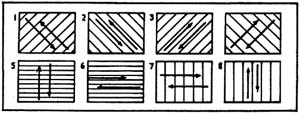
Figure 1: The kinetic movements and the background after Nilson page 108.
(what cinema gives us) is not the frame (photogramme in French), it is a medium image to which movement is not added..: the movement belongs to the medium image immediately... cinema does not give us an image to which it adds movement, it gives us from the very beginning an "image-movement". It gives us a frame, but it is a mobile frame and not a immobile frame + abstract movement. (Deleuze 1983, 11)
So from the very outset it could seem senseless to compare composition problems within two different kinds of pictures.
Often titles like "Theorizing the Moving Image" give us the impression that the notion of "moving image" is a particular phenomenon within-or an exception to-the general notion of "picture" or "image", understood as still pictures. And from a historical point of view, that is true.. We made still pictures 30.000 years ago, we have experimented with moving pictures for only a few hundred years.
But if we think of our visual perception of our environment, it is more likely to be the other way round. We are always moving eyes and body when we use visual perception to orient our actions in the world. Our perception is bound to movement in a three dimensional world. If we want to make still pictures according to the laws of central perspective, we have to use artifacts: we have to keep one of our eyes completely immobile, while closing the other one, and at the same time we have to use other devices in order to reduce our perception of the three dimensions to a flat picture. Just think of Dürer's famous woodcut of the artist drawing a naked woman seen through a window with squares while keeping his eye immobile near a pointed stick.
So we might ask ourselves whether the still picture is not the special case and the moving the normal one. The moving image being a replica of our perception and the still picture a pure sign? A joke? Maybe. Could we say that the moving picture is less coded and closer to normal perception and that the still picture looks more like a true sign? If you want a more serious discussion of the relationship between percepts of our environment, moving pictures and still pictures, read Messaris 1995, 12.
At least we have to admit that pictures have a frame (in the sense of edge or limit), something is within the frame, something else is outside the frame. Almost all producers of pictures agree that balance (harmony or disharmony) is important. Frame and balance seem to be common ground. But how do they work in relation to the two kinds of pictures? Do we have to admit that the differences are predominant?
Two or three arguments at least seem to indicate that there is some relationship between the two kinds of pictures, and that the discussion of that relationship could be useful.
A) Most or at least some practical books on film and/or television production use the language of the analysis and the description of still pictures (see below Monaco 77/81 and Thorsen 1994).
B) Very often you find a quotation of a painting or a pictorial tradition within a film; some film makers integrate still pictures and architectural elements as part of the story like Fellini or Antonioni.
C) The relationship between what is seen within the frame and our inference
about what lies outside the frame, is extremely important for both kinds of
pictures. How do we "see" what is outside the frame? This is a problem that has
been known to painters long before it became one for film makers-at least since
the Italian Renaissance. The amount of horses that continue outside the
painting or that come in from outside!
In How to read a film (Monaco 77/81), Monaco discusses frame/out of frame relations and refers in this context to Arnheim 1974: How do visual elements function within the frame (Monaco 77/81, 149)? But he restricts himself to 1) a discussion of the limitations imposed by the frame ratio (1: 1,33, 1: 1,66, 1: 2.33) and 2) the composition of the image/picture.
As for the ratio of the frame Monaco specifically mentions the types of scenes or interactions that are typical or possible in the various formats: Dialogues in 1: 1,33 and large landscapes in 1: 2,33. This particular point could give us access to general rules common for moving and still pictures: the links between format and theme or content.
As for the frame problem, Monaco restricts himself to discussing the limit of the frame and the movement of the actors (the open and the closed form): Is the space created by the frame closed (the camera following persons who do not leave the screen)? Or is the space on screen open (people leave the screen)? cf. Monaco 77/91, 151.
In L'image-mouvement, Deleuze exposes his theories about the framing in film (cadrage, champ et hors champ):
The framing (cadrage in French) is the art of choosing or selecting elements of all kinds that enter into this totality. This whole is a closed system... The closed system, determined by the frame, should be considered in relationship with what it communicates to the spectators (Deleuze 1983, 31- 32).It can be considered as aiming at information, in this case it can be full (saturé) or it can be almost empty (raréfié).
If the system is considered in itself and as a limitation, it is either geometric or physical-dynamic. By "geometric" Deleuze means that the frame (the picture plane) is already organized geometrically "a composition of space in parallels and diagonals, the constitution of a receptacle in order to permit the masses (shapes) and lines of the image that occupies the space to find an equilibrium" (Deleuze 1983, 24). Everything is ready to receive the content which has to conform to the geometric pattern that already is there. It should be noted that equilibrium is a system that exists before the concrete elements that fill in this system. Deleuze is in fact fairly close to Arnheim's theory about centric and eccentric composition (cf. Arnheim 1988, 2- 12 and below 3.1)
By physical-dynamic, Deleuze understands that the frame/surface is considered as an ongoing dynamic construction that depends on the scene, the actors and the objects that fill in the frame. Here the concrete elements precede the geometrical pattern (cf. Deleuze 1983, 24- 25).
The geometric version stresses the lines of division and coherence while the physical version stresses the gradual changes.
Framing is the basis for the angle of the camera and thus for the point of view (cf. Deleuze 1983, 27)-any strange angle requires a justification within the film. This is a very explicit demand that any changing, any choice of camera angle should have a reason within the logic of the film.
Finally the framing determines the off screen space, be this space a prolongation of what is on screen or be it a totality that integrates what is on screen (cf. Deleuze 1983, page 32).
Monaco notes that the relations between the movements within the frame and the movements of the camera, constitute a very sophisticated code (cf. Monaco 77/81, 151). These interactions between movements are related to the interactions between moving and static elements within the frame. You find a rather old, but very informative presentation of the issue in Cinema as Graphic Art (Nilson 1959):
The dynamics of any shot may be displayed by means of the direct movement of the object in the shot (or the movement of the camera view point in relation to the object), and also by a suitable form of compositional construction of the static object. In the first case the predominant factor in the dynamics of the shot will be a direct kinetic movement. In the second case it will be a potential movement of representational forms static in them selves, and expressed and emphasized by the compositional construction (Nilson 1959, 108).Nilson describes the interaction between the kinetic movement, the static obstacles in the design of the ground and the frame. This is illustrated by a rather geometric representation showing the frame with linear obstacles and arrows indicating the kinetic movements of the objects.
Nilson's presentation shows that the interaction of the different movements are extreme important for the dynamic figure-ground relationship; the dynamics are emphasized "by the contraposition of the objects' movement with the composition of the background and... by the conflict between the direction of the movement and the side of the frame" (Nilson 19959, 108).
Figure 1: The kinetic movements and the background after Nilson page 108.
Let us take a look at the importance of movement for the perception of figure and ground.
1) The camera is immobile, the elements (actors, special objects) are immobile. This is the normal figure-ground relationship well-known from still pictures.The figure-ground relations are thus dependent on movement. There is nevertheless a clear similarity between figure-ground relations in moving images and in still pictures; but the moving images have a wider range of variations.2) The camera moves, the elements are immobile. This is what would look like the simple parallax movement: New figures appear-or what was at first perceived as ground turns out to be figure.
3) The camera is immobile, the elements move: this is the clearest division between figure and ground.
4) The camera and the elements move. If the camera and the elements move at the same speed and in the same direction, the ground appears clearly as background. But things are much more complicated: differences of direction and of speed are of crucial importance in this context.
In a balanced composition all such factors as shape, direction and location are mutually determined in such a way that no change seems possible, and the whole assumes the character of "necessity" in all its parts. An unbalanced composition looks accidental, transitory, and therefor invalid. Its elements show a tendency to change place or shape in order to reach a state that better accords with the total structure. (Arnheim 1974, 20)In The Power of the Center (Arnheim 1988), Arnheim presents two principles: 1) The centric composition, where the radiance of the center is the dominant force; and 2) the eccentric composition, where the forces or the vectors divide the picture plane and cross each other (Arnheim 88, 2- 12).Equilibrium we noted, is attained when the forces constituting a system compensate one another. Such compensation depends on all three properties of forces: the location of their point of attack, their strength, and their direction. The direction of visual forces is determined by several factors, among them the attraction exerted by the weight of neighboring elements. (Arnheim 74, 26)
These principles are given by the frame and they are at least somewhat similar to Deleuze's principles. They have a great importance for makers of still pictures, as the following quotation clearly shows. In 1995 the Danish television channel DR1 broadcast an interview with the painter Per Kirkeby Med Kirkeby på Læssø. The theme of the interview was the relation between the construction of pictures (paintings) and nature. At the beginning of the interview, Kirkeby makes some statements about the strength and the balance of pictorial compositions.
if a picture functions a decision has been made for the totality of the painting-there must be not even one square inch giving the impression that you have not made a decision... what you experience-your environment must have made a decision-everything should be at its right place-when a painting is finished I have the impression that every element enters into the whole-fits into the whole-you can't get it out (saying this Kirkeby makes some expressive movements with his hands or rather his fingers) it's like a puzzle when the last piece has fallen into place-Gloc-like this then you can breathe but some times it can be very hard... the elements won't fall into place... (Per Kirkeby in Med Kirkeby på Læssø, DR1, 14.2.1995)This all points to the fact that pictures - be they paintings or photos - are balanced compositions. Even the press photo obeys normally the "rules" for balanced composition (and of course the rules for destroying balance).
If we take a look at film and television theory, there are rather few discussions about the principles for balanced composition at work in still pictures compared to the same principles at work in moving pictures. Monaco talks about the "static film frame" as opposed to the diachronic shot" but "static film frame" is not exactly the same thing as a still picture.
But how can a principle of dynamic balance (the movement is brought to a stop at a unique point where opposite forces counterbalance each other) have any importance in a visual representation that is characterized by changing, which implies that the unique point is not unique but variable? We are back to the initial statement of Deleuze.
Does this mean that film and painting entirely differ in this way? Or is there still some common ground?
3.2
The balance problem
As an introduction to these issues, let us have a look at chapter III, 4
"Billedkomposition" in Thorsen 1994. This is the basic book on television
production in Denmark (television for journalists, not for film makers).
The chapter III, 4 begins with a description of balance-that is strangely related to the ways television can capture the viewer's attention. According to this, the main problem is that the left side of the picture contains the past and the right side the present/future, a problem that is discussed in Kress 1996, 186-187. This means that the right side of the frame is heavier than the left. It is never said explicitly in Thorsen 92 that the point of departure of the whole description is an immobile camera, but the entire presentation implies this use of a camera. The only movement possible is the movement of one of the elements on the screen.
The text is very much focused on the golden section, that is presented as four points that are particularly good for capturing the viewer's attention. The illustration in the book (page 107) is not the best proof of this thesis. But this is not our concern. What matters here is the fact that if the golden section is reduced to four attention points, then the objects in the frame have to remain at exactly the same point and thus the camera and the objects have to be totally immobilized or the objects and the camera have to move at exactly the same speed and with an equal movement. How do movement and balance interact? If we take over Arnheim's definitions of balance, a short immobilization seems to be necessary for the image to create balance or rather to enable us to perceive balance-but for how long? One second? Two seconds?
Thus the few pages of Thorsen 1994 on balance present more problems than solutions.
The problem of the three dimensional illusion on a two dimensional screen is presented in twelve lines! The three dimension illusion is, according to the text, obtained by the classical use of foreground, middle- and background. There is here a total confusion of the ways the moving picture creates depth as opposed to the ways the moving image creates the illusion-but the description is correct if the camera does not move.
The whole problem of balance, as it is presented in the literature, is normally related to two dimensions, to the picture plane, the problem of balance is seen as basically the same whether we have a "realistic" picture (i.e. with a three-dimensional illusion) or an abstract picture.
Balance-in-depth (the geographical plane) is restricted to sculpture. And this is the problem with filmic movement (and to a certain degree to TV movement): it creates some kind of equivalent of the parallax in perception.
A similar mechanism is operative in time parallax, when different images result because the viewer changes location. When one moves one's head from side to side one receives different images, which again can be fused into a unitary three-dimensional image... In the arts (this depth indicator) is employed when the eyes of the viewer or the motion picture camera move from one station point to another, thereby strongly increasing the depth effect of the solids perceived. A corresponding effect is brought about when a sculpture is made to rotate on a turntable.This quotation makes it clear that the difference between moving pictures and still pictures is profound and that the perception of balance must be different in the two cases. Or should we say that the conditions of perception are different?Neither spatial nor temporal parallax can be employed to increase depth in flat pictures. On the contrary it serves to reveal the flatness of the surface. The depth effect of a picture is increased when one eliminates parallax by looking with one eye from a strictly immobile position (Arnheim 1974, 270- 271).
But how do we recognize Millet's humble peasants in a film about the sexual desires of the modern French middle class? And how do we recognize the original's man + woman in the two men in Bunuel's film? By the position of the two persons on the screen (distance to the frame and distance between the persons), by their general outline. But two conditions must be fulfilled:
1) The spectator must know Millet's painting (!); 2) the scene must last as long a time as is required for us to recognize the painting (!!). Is an immobile camera necessary as a third condition? Or could we recognize Millet even if the camera moves-in which case the recognition is due only to the general outline of the persons and the space between them?
In other cases the relationship between film and painting is not a matter of using or recognizing a specific picture, but a matter of style: principles of composition, use of light, colour, texture. In this case it is much more difficult to make statements about the relations between film and painting. A very recent example is the Danish television serial Bryggeren that seeks by all means to reconstruct a "correct" historical environment. The first four episodes lean heavily on Danish art from the first half of the 19th Century: the choice of the colours, the indoor light, the architecture, etc.
In his 40 minute short film Une partie de campagne, Jean Renoir makes certain references to the painters who were colleagues of his father: the environment, the use of textures (the water). There is in his case a transfer to the film maker not only of aspects of the painters' universe but also of the painters' ways of seeing nature. It is not a direct borrowing, it is not the use of a tradition as such, but a more subtle way of using the tools or rather the eyes of one art within another art. In this case, the paintings of Monet and Sisley that are high in colour serve as models for a black and white movie.
There are three questions in this context:
A) What are the functions of the direct use of specific paintings-symbolic values, historical realism, etc.?
B) To what extent are the film makers conscious about borrowing from painting traditions? For example, in Eating Out, Sletaune uses composition principles that go back to Italian art from the 16th Century. But what are the threads that go from Tintoretto to Sletaune?
C) The last question is related to what has already been mentioned: to whatever extent movement changes what is borrowed from painting, can the balance of the picture still be maintained undisturbed on film?
In Cinema and Painting (Dalle Vacche 1996), Angela Dalle Vacche examines the ways a specific painter or a specific pictorial tradition are used in a particular film, giving this particular film its specificity. It is a study of intertextuality according to Angela Dalle Vacche herself. In her study she gives clear answers to the first question (the functions of the painting in the film), she is very hesitant about the second (the historical filiation) and the last question is never even asked.
Angela Dalle Vacche is very concerned with problems of art, "high art," as she herself makes clear (Dalle Vacche 96, 2):
By looking at eight films produced under different historical circumstances and in different cultural contexts, each directed by strong creative personalities, I ask: what happens to the paintings used or alluded to in these texts (Dalle Vacche, 96, 2).Unfortunately Angela Dalle Vacche excludes any film that is not a "film d'auteur" and that could rely on other visual expressions than "fine arts"-a film like The Price is Right would thus be excluded, because it seems to rely very much on popular layout from magazines or advertising.
This somewhat invalidates Angela Dalle Vacche's text since the book cannot tell us very much about general principles for the relations between two visual systems: the moving image and the still picture and its context (lay out). Angela Dalle Vacche focuses on interpretation of the individual film maker's unique relation to a specific pictorial expression. In any event, there is a discussion about the importance of camera movement and intertextuality (93 and 104) in some places. In the chapter on Rohmer's La marquise d'O, Angela Dalle Vacche notes the importance of the fact that Rohmer very seldom uses camera movement.
The filmic space of The Marquise of O is characterized by such austerity that the few movements the camera makes acquire undeniable significance, if not deep emotional resonance. (Dalle Vacche 96, 104)Angela Dalle Vacche is right in pointing out the importance of the movement in a film that is characterized by an immobile camera, but she never takes up a general discussion of the overall relationship between the use of mobile and immobile camera, and of balance or harmony as related to movement/absence of movement. And how this might be related to the pictorial traditions.
For each of the films the following five issues will be examined:
The pictures and the space: Deleuze's notion of geometric composition, Arnheim's notions of centric and eccentric composition, the notions of balance.The three films will not, of course, be submitted to exactly the same treatment. The main problem is what happens when these principles are applied to still images and what happens when they are applied to moving images.The notions of dynamic and ongoing processes: Deleuze's second category, the importance of movement and depth as opposed to balance
The framing and the figure-ground relations.
The framing and the in frame/out of frame relations.
The relationship between the filmic image and pictorial works and/or traditions (in a broad sense).
Here are my first impressions of the films:
Eating out looks rather like a movie, the action takes place in a well defined space. The movements are easy to perceive and there is a clear distinction between movement and immobile camera.
The Price is Right looks like an advertisement, a TV spot; the movements are uncontrolled, they may contradict each other, the film never seems in balance.
The Beach is characterized by slow movements. You have the impression that total immobilization is nevertheless an exception. This gives the film a smooth and even harmonious aspect.
These first impressions are to some extent confirmed by the number of shots and the average length of the shots, cf. Philippe Viallon's article.
5.1
Eating Out
Eating Out is the most classical of the three films. There is relatively
little camera movement or rather the movements are not spectacular with some
few very important exceptions. Eating Out clearly uses geometric framing
in the first shot: the burger is placed very near to the center and in the next
"cooking shot" the burger has been moved slightly in order to let the piece of
cheese have space enough to be placed in the diagonal (bottom left to top
right) that has a third element top right. The image is simple and carries very
little information; the spectator doesn't need more than a fragment of a second
to feel the power of the center. In the third cooking shot the burger is placed
rather low and slightly to the left. This position is reinforced by the sound
of the ketchup and the thunder. In Arnheim's terms, eccentric movement has
taken over. In Deleuze's terms, the physical-dynamic composition principle
turns up.
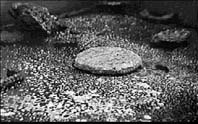 Figures 2 and 3: The power of the center |
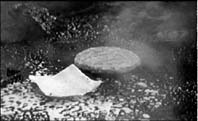
|
 Figures 4 and 5: The geometric composition. |
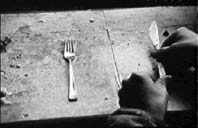 |
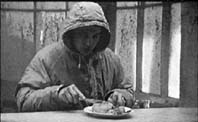 Figures 6 and 7: Parka eating. | 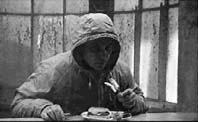
|

|
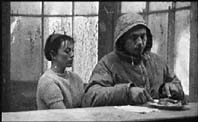
|
The main composition piece is the counter. The rest of the scene depends on this composition, which is physical and dynamic as well.
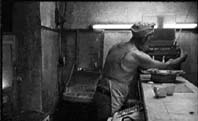
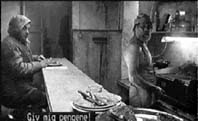 Figures 12 and 13: The counter as indicator of depth.
|
Figures 14 and 15 show two almost identical shots. The vanishing point of the counter's edges are just before the face of the cook. Roy's arm (the upper edge of his sleeve!) points at the vanishing point and thus at the cook's face, but the pistol is pointed at his throat.
The fact is that we have: a) an (almost) immobile camera; b) a clear composition; and c) concerning the burger-in-the-center and Julie/the-Parka-behind-the-counter, a repetition of the shots. This makes the shots familiar to us, it stresses the position of the elements and we remember/retain the principles of the composition. I think that in these cases the principles for balanced composition in the still pictures are also valid in the moving pictures.
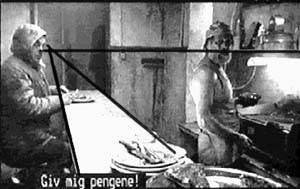 Figure 16: The triangular compositions.
|
Thus the principles of balanced composition are followed by Sletaune and these principles are perceived by the spectator in many of the shots in this film because most of these shots use an immobile camera, and because they last long enough to insist on the composition. Some shots are repeated which is another way of insisting and the camera movements often end with a brief moment of immobilization. This last case is best illustrated by the circular movement made by Roy, the cook and the ever turning dish on the counter: the cook seen from the back moves left and Roy moves to the right, then we change almost 180 degrees (at least we look now from the other side of the counter), the cook is seen frontally, he moves a fraction of a second (or the camera moves to the left) to the right and stops with a tremendous insistence on the still: we do not need much time to see that he stops just before transgressing the vertical middle. We end up with a composition obeying "eternal aesthetic principles"!
The camera follows the movements of Julie, Roy and the cook, and thereby presents the whole visual universe; there is nothing visual outside. The whole universe is covered by the camera. We have thus a totally closed world-the outside is made up of sound, two different sounds. The frame is a limitation without anything outside.
At one point, the film uses two contradictory movements or codes of dynamics, one belonging exclusively to the moving image the other one to both moving and still images. Nilson discusses "types of compositional construction in which the dynamic tendencies are revealed in the potential movement of representational forms which in themselves are essentially static". In Eating Out, Roy expresses a potential movement by pointing the pistol at the cook. When he advances in the beginning, kinetic and potential movement converge, but when he is leaving, the static and the kinetic movement diverge: Roy's failure is complete.
The figure and ground relations are very complex in this film, but seem to have a solid resemblance with what is typical for the still picture. In the shots with Parka eating and with Parka + Julie, the windows and the door form a clear-cut (and almost flat) ground. But as soon as the table is seen in an oblique angle, things change and an object that is figure as opposed to the whole frame, becomes ground in relation to a smaller object.
The whole film shows a kind of anti-aesthetic aesthetics: We have a room, built up according to good architectural principles, with actors that place themselves in the proper and harmonious ways, but unfortunately the texture and the colours contradict the architecture.
The framing of the persons by vertical (architectural) elements can be found in the graphic works of Albrecht Dürer or Florentine painting and so can the horizontal cutting of the persons by the counter. Both principles are at work in Dürer's wood cut The Men's' Bath from 1496. The cutting off of the persons can of course be found in most representations of the Last Supper from the Fifteenth Century on.
The division of the picture into three parts (a low horizontal rectangle in the bottom, and the upper cut into two squares) goes back at least to the Italian Renaissance (Titian's Venus of Urbino from 1536).
The oblique position of the table has been used in painting since the invention of the central perspective in the 15th Century, but then with a vanishing point in the middle of the picture. Sletaune stresses the oblique lines of the table by stretching it down to the bottom (in fact by cutting it) and by giving it a vanishing point placed in high in the left side of the frame. These experiments with eccentric vanishing points begin with Italian mannerism: The Last Supper of Tintoretto (1592-94).
I am not desperately seeking for pictorial references coming out of the blue. The simple fact is that Sletaune uses architecture in his mise-en-scène and then there is no way out: the geometrical principles go back to the Renaissance.
We never see the floor in Eating Out. It is possible that this stressing of the composition of the picture plane, and the subsequent downgrading of the geographical plane, reinforces the resemblance with older pictures.
The insistence on geometric principles obtained by clear compositions (oblique vertical and horizontal lines and the stressing of the center) combined with the immobile camera (used in two ways) and the repetition of shots, makes the perception of still picture principles easy in this film(!).
5.2
The Price is Right
Apparently, this film does not seek to obtain any kind of balance, it is filled
with moving elements, a moving camera, strange low angle and high angle shots.
Statistically not very much more than Eating Out, but the movements are
used in a different way and thus the immobilization of the camera acquires
different functions. If you look at the statistics of Philippe Viallon, you see
that the shots are shorter in The Price is Right.
Are there examples of geometric prestructure or patterns? We see the two protagonists standing in front of each other and talking after work, but there is no research of balance, only the simple necessity of placing the two persons in vertical position in front of each other.
In The price is Right, it is easier to see the frame as a dynamic composition, totally dependent on what is going on: the parody of singing in showbizz with the long traveling in depth.
The definition of figure and ground by the frame is not clear: the figures obviously have some difficulties in getting out of the ground, the smaller elements fuse with the ground as a texture. Just think of all the scenes in the supermarket or in the television studio. The ground is made of different objects, all wrapped in similar packing and with a dominance of yellow-red colours. In that way, even the protagonists dressed in yellow look like the ground. They too seem to fuse with the ground, at least until the end of the film.
And the even more-in The Price is Right we see the floors, but in fact there is no horizontal space, it is as if everything is integrated into the ground, a kind of vertical tapestry.
We know what is outside the frame, but we are not concerned about this. According to Monaco when the camera follows the protagonists we should have a closed world (as in Eating Out) but as a matter of fact the dilution of the objects into the ground concerns also what is outside the frame, but this outside seems to fuse too.
According to Deleuze, there should be a reason for every camera angle. I am not sure that all the strange and odd uses of camera angles are justified in this film except in one way: they all relate the film to the advertising universe, the universe of showbizz, of the music video where the camera angle often has no other justification than to stress the aesthetic specificity of the genre.
Despite Dalle Vacche's claims to the contrary, a film can easily be based on an aesthetic tradition that has nothing to do with fine or high art and still have aesthetic values. This is the case with The Price is right. The film relies on the style of advertising, the lay-out and the use of pictures in popular magazines. You may call it anti-aesthetic, but that is a kind of aesthetics.
This style is far from high art, it does not give us a profound aesthetic satisfaction. It is irony.
5.3
The Beach
The film begins with an establishing shot, a pan, in fact there is a dissolve
in the middle where two rather different landscapes are fused into one and the
pan is changed into a traveling. (I did not notice the trick when I first saw
the film). Both landscapes are rather flat (except near the dissolve), there is
very little vegetation or some pale grass, the colours are pale. The pan +
traveling presents the whole universe of the film; there is nothing but this
rather flat land (dunes and the shore), water and sky, three zones.
This is the ground defined before we see any figure. The figures are persons, a ball, an umbrella and some clothes and bag. A minimalist universe wrapped in a pale sun light.
In contrast to the two other films, the figure-ground relation is extremely clear. The flat horizontal ground has a tendency to disappear into emptiness. Very different from Eating Out where some elements change from figure to ground or vice versa in a complex figure-ground constellation, and different too from The Price is Right where the ground absorbed the figures.
But still the frame defines the ground, the chosen section.
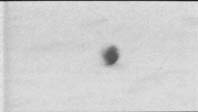
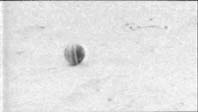
|
Though these shots are not very long, they may seem longer than they are as a result of the delicate or hidden montage.
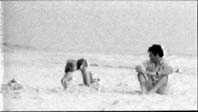 Figure 23: Triangular composition. |
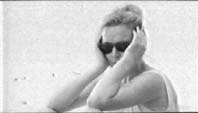 Figures 24 and 25.
|
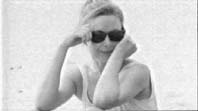 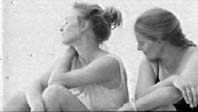 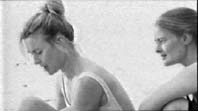 |
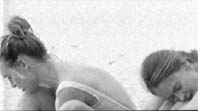 Figure 30. | |
The bodies get into different shapes, mostly variations of triangles, "the frame is considered as a dynamic composition in process, depending on the scene..." (Deleuze 1983, 24)
Later when the man comes back to the women, they form a group; they sit in an almost symmetrical composition.
Let us resume the principles that are at work in this film:
This film works very much according to the principles of balance that have been discussed. It creates the feeling of the balance by slow, "short" and interwoven movements either by the persons or the camera. This gives the film an aspect of smooth rhythm, a movement that often ends in a total immobility. We have a dynamic composition
As the ground is almost reduced to nothing, the film gives us in many cases a strange impression of two-dimensionality, no impression of depth, a sculpture with nothing behind it.
The frame only presents a part of the total background, but this background is always present for the mind, we know the whole possible background, we know that the ground (emptiness) continues without interruption on both sides of the frame-and there is nothing behind the emptiness.
This film looks pretty much like "high art". It should be possible to find paintings that show the same minimalistic use of pictorial elements: a flat, uniform background with pale colours and little colour variation and some few sculptural figures sitting very near the picture plane.
This film has no clear-cut lines. I have talked about sculpture, but paradoxically it gives a rather graphic impression. I have not found the direct pictorial models. It is at any rate not impossible that the graphics or drawings of Picasso (the classical period or possibly the blue period) work along similar aesthetic principles.
6 Conclusion
Balance, movement and immobility.
What appears in these three films is that movement and immobilization/immobile moments are interdependent, imply each other. The importance (and the perception) of the immobile periods depends on the movement in different ways. If the movement suddenly changes speed, if there are jumps, balance cannot be the result of the movement.
Balance also depends on the way the framing works: geometric space or dynamic composition. The laws or the principles of balance are basically linked to the immobile periods as starting point or arrival point of the movement.
The balance or the perception of balance is also dependent on the figure- ground relationship. If the distinction between figure and ground is fuzzy, we can only perceive balance with difficulty as is the case with The Price is Right. The Beach gives a total impression of balance and Eating Out is in somewhere in between.
As for the aesthetic traditions:
The Price is Right displays a total absence of classical aesthetic principles, and a total dependence on popular magazine/television lay out-the triumph of a non-balanced world-but with a content giving us hope of getting a balanced and happy life!
Eating Out displays all the principles of classical picture composition and thus of balanced composition, but texture and the whole environment contradicts the classical composition. The content is ambiguous: is there a way out of the burger bar?
The Beach displays all the principles of balanced, aesthetic compositions, in a minimalist and dynamic composition. But the story contradicts this display of formalistic beauty.
Arnheim, Rudolf (1974): Art and Visual Perception. Berkeley, University of California Press.Arnheim, Rudolf (1988): The Power of the Center. Berkeley, University of California Press.
Dalle Vacche, Angela (1996): Cinema and Painting. Austin, University of Texas Press.
Deleuze, Gilles (1983) L'image-mouvement. Paris, Editions de minuit.
Kawin, Bruce F. (1987): How Movies work. Berkeley, University of California Press.
Kress, Gunther and van Leuwen, Theo (1996): Reading Images London, Routledge.
Monaco, James (1977, 1981): How to Read a Film. New Yourk, Oxford University Press.
Messaris, Paul (1994): Visual Literacy. Boulder, Westview Press.
Nilson, Vladimir (1959): The Cinema as Graphic Art New York, Hill & Wang.
Thorsen, Michael og Møller, Hans-Georg (1992); TVjournalistik, Århus, Ajour.